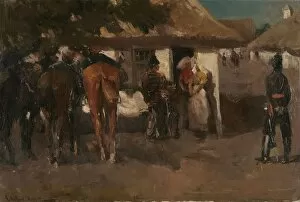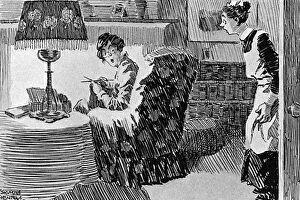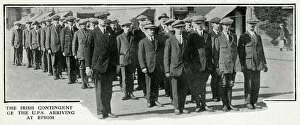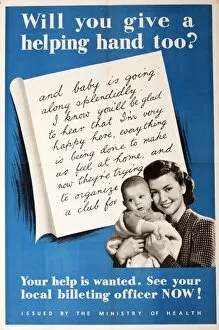Billeting Collection
"Billeting: A Glimpse into the Lives of Soldiers, Evacuees, and Stately Homes" Food for billeted soldiers during WW1 - a comforting taste amidst chaos
For sale as Licensed Images
Choose your image, Select your licence and Download the media
"Billeting: A Glimpse into the Lives of Soldiers, Evacuees, and Stately Homes" Food for billeted soldiers during WW1 - a comforting taste amidst chaos. An evacuee arrives at her new home with the Billeting Officer, seeking safety and solace. Welcome guests in a stately home of England, 1914 to 1919 - where grandeur met wartime resilience (b/w photo). Sketches at Trebizond capture the essence soldiers during war times (engraving). The War's impact: billeting Circassians on a hotel at Nicopolis - an engraving that tells tales of cultural adaptation. The Bill for Billeting Soldiers during WW1 - a reminder of the sacrifices made by both soldiers and civilians alike. Billeting soldiers with humor during WW1 - finding laughter amidst adversity. "A Subaltern's Stunts in Italy" by H. L Oakley showcases daring acts intertwined with moments of respite from billeted life. Silhouetted stunts captured by H. L Oakley reveal shadows dancing against the backdrop of wartime challenges. Irish contingent of UPS arriving at Epsom, Surrey during WW1 - unity through shared experiences in unfamiliar surroundings. Billeting troops quartering soldier's houses village-wide – forging bonds between communities and those who serve them selflessly. Caring for evacuated mothers and babies – compassion amid displacement; nurturing hope even in uncertain times. In these glimpses into history, we witness how "billeting" played diverse roles throughout different periods and contexts—providing sustenance to weary warriors, sheltering evacuees seeking refuge from conflict-ridden lands, showcasing hospitality within magnificent estates while also fostering camaraderie among troops stationed far from their homes.















